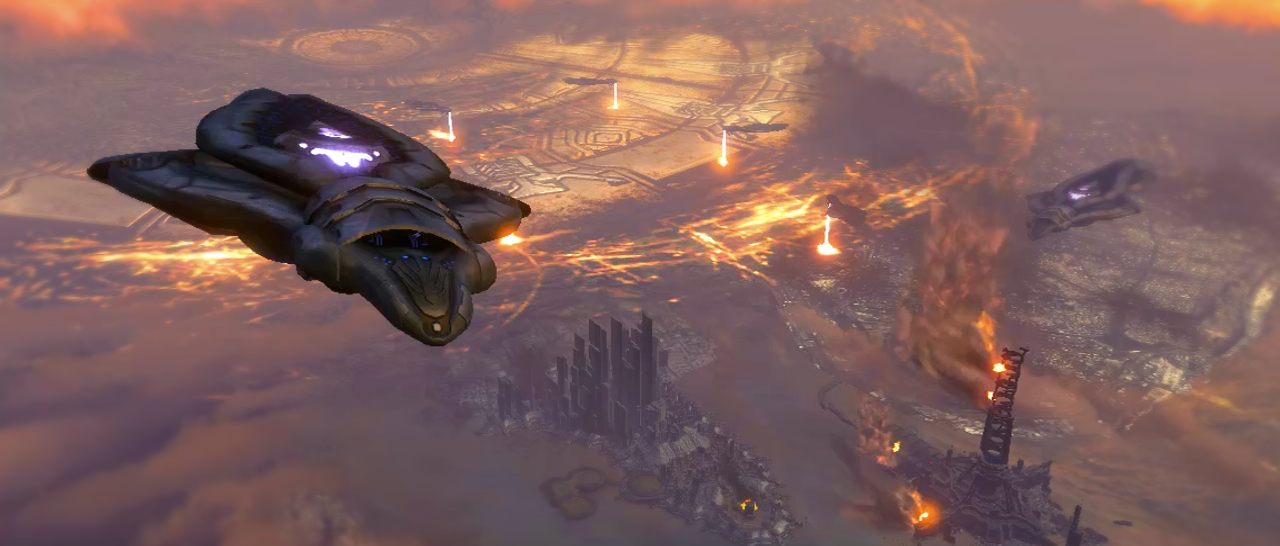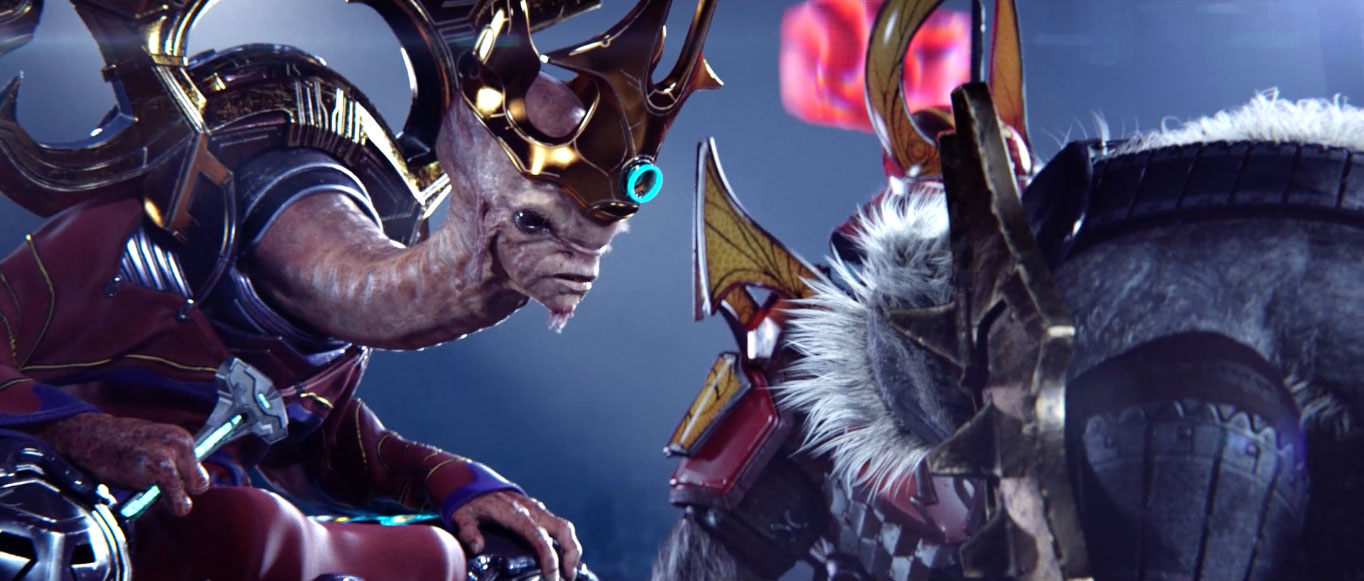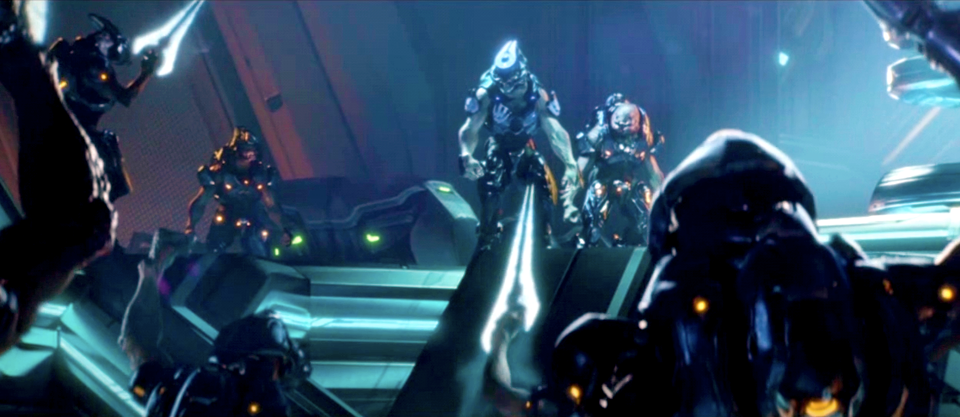“An empire founded by war is to maintain itself by war”.
–Charles de Montesquieu
Superficially, the alien collective known as the Covenant came to an end in late 2552, after the High Prophets approved the Jiralhanae’s replacement and extermination of the Sangheili. By March 2553, the Sangheili under command of the Arbiter made official a tentative truce with humanity; it was this alliance that had stopped the Prophet of Truth and the last of his loyal forces from destroying the galaxy’s sentient life at the Ark.
That the final spark that caused the sundering of the Covenant was the Great Schism, however, is largely immaterial. From its inception, the Covenant was a broken alliance that was doomed to destruction from within. While the war with humanity hastened its collapse, the signs of its failure were apparent long before. But though the political apparatus underpinning the Covenant fell apart in 2552, the legacy of the Covenant—and those still claiming its legitimacy—remains even in the new galactic status quo of 2558.
So full of hate were our eyes
That none of us could see
Our war would yield countless dead
But never victory
So let us cast arms aside
And like discard our wrath
Thou, in faith, will keep us safe
Whilst we find the path
–Covenant Writ of Union
Covenant history begins at the start of a protracted war between a group of San ‘Shyuum Reformists and the Sangheili. The conflict was sparked by a key disagreement between the two species over the handling of Forerunner relics, sacred to both cultures. The Sangheili considered tampering with the artifacts of their gods verboten; the Reformists had left behind the rest of their race, who had believed much as the Sangheili did, and were on a quest to derive new technologies from the relics.
The war turned into a bloody stalemate that neither side could not afford to wage. The Sangheili, outmatched by the powerful Forerunner Dreadnought the San ‘Shyuum fielded, were forced to violate their tenets and attempt to engineer defenses from their own Forerunner relics. The San ‘Shyuum, already few in number, realized that annihilation of their entire group would be all too easy, especially if another race such as the Sangheili still stalked the void of space.
The eventual alliance that formed the Covenant had simple enough benefits for both cultures. The Sangheili, a proud warrior race, accepted partnership with their opponents, who could study Forerunner technology to improve both cultures’ capabilities. The San ‘Shyuum’s understanding of Forerunner matters meant they had the best chance of discovering more relics and ultimately attaining godhood like the Forerunners. For the San ‘Shyuum, a practical and conniving group whose survival depended on these very qualities, good protectors were a necessity in a hostile vacuum. In this new order, the San ‘Shyuum adopted the spiritual role while the Sangheili held responsibility for all military matters.1
And yet as soon as the Covenant was spawned in 852 BC—the same time Homer was composing paens to the classical world’s wine-dark sea–the foundations were on shaky footing. The truce required no side to admit the error of their position, which meant that the issue of proper handling of Forerunner relics was merely sidelined by convenience, never solved. The San ‘Shyuum saw their new protectors as simple, more concerned with bloodletting and honor than the practical. The Sangheili, meanwhile, viewed their new scientists and stewards as slippery and guileful.
Furthermore, the lack of integration between the two societies meant that there were no other cultural ties to strengthen the alliance. There was a reason that European royal families of yore backed up peace treaties by offering daughters and sons in marriage—strengthening family ties between competing factions was one way of helping defuse tensions. But aside from the biological impracticalities of intermarriage in the San ‘Shyuum and Sangheili’s case, the lack of any effort in adapting each others’ cultures meant that no real assimilation between them ever occurred. Once the San ‘Shyuum decommissioned their Dreadnought’s weapons and used it to power the mobile capital city of High Charity, they lost their main position of strength—their superior firepower and mobility. From then on, they were at the mercy of the Sangheili, whether either side realized it or not.
Perhaps this imbalance was one of the reasons that the Covenant offered its promise of salvation to other races. The first to be incorporated were the Lekgolo, whom the Covenant discovered eating their way through Forerunner metals. Then came the insectoid Yanme’e, the plundering Kig-Yar, and the crab-like Unggoy. This offer was not exactly made graciously, usually only coming after a near-catastrophic war for the new client race. A key shared pattern in this forced conscription was that each race, like the Sangheili and San ‘Shyuum, retained a large degree of autonomy. The Kig-Yar, an ancient race with deep ties to piracy, accepted letters of marque from the Covenant. They often operated as privateers like those of Earth’s 18th century seas, continuing their marauding ways under the banner of the Covenant. The Yanme’e remained almost entirely separate from the rest of the Covenant, only interacting in issues of trade and combat. Likewise, the Unggoy’s natural tendency to breed uncontrollably constantly led to population pressures, but they retained games and customs from their homeworld.
As a result, Covenant member races were cohered by only two factors—a carrot and a stick. The carrot was the Great Journey. While the promise of salvation for all who follow is an effective tool, it is a transcendent common goal, not a practical one. The validity of the religion was conflictingly accepted as well; many of the Sangheili who followed the Covenant did so out of convenience and technological considerations, and some resisted many years after the Covenant was founded.2 Some San ‘Shyuum believed in the Forerunner’s divinity due to the absence of evidence to the contrary, rather than any deeply-held conviction.
The stick, meanwhile, was total destruction. A civilization that has the power to obliterate one’s entire planet is a psychological weapon as well as a physical one.

“Directly preceding their assault on the colony world of Biko, the Covenant transmitted a message to its surface. Within this message was a bold claim: ‘your world will burn until its surface is but glass’ – a claim that clearly indicates the Covenant leadership believes they possess the power to literally reduce a planet’s surface to a molten state. Assuming they have the wherewithal to back-up such a claim, the dangers to our creators are obvious.
The implications for their own internal politics are also instructive e.g., what effect might the Covenant leadership’s assertion have on any client species in their coalition? We aren’t the only beings that would be terrified by the idea of absolute destruction of a planet’s surface—nor would we be the only ones to realize the futility of attempting to resist a force that has such power at its disposal.”
—The Assembly, Data Pad 10
Any rebellion by any member race would threaten not just their lives, but their entire species. Individuals can be motivated to sacrifice much, including their own lives, but that incentive usually stops with the threatening of one’s friends, families, relatives and the obliteration of the sum of their race—art, language, culture, geography.
Even this threat, however, was not enough to stem the Grunt Rebellion—a conflict that nearly saw the lowly Unggoy rip apart the Covenant and forced the commissioning of an Arbiter to bring the creatures back into the fold. The immediate cause was the corruption of Unggoy narcotics by Kig-Yar vigilantes, but this rebellion was not an isolated incident; Sangheili warlord Ripa ‘Moramee had to put down a similar insurrection. Covenant history was rife with ages of conflict and discord—it seemed the rule, not an exception.3
The center cannot hold
In human history, mere threat of force is often not enough to stem rebellion—it requires an active destruction of anything that can spark the desire to rebel. And this is where the Covenant’s sectionalism created the fractures that would destroy itself. By not fostering a common culture, each race was left with its own value system and culture that would breed dissent. The San ‘Shyuum considered allowing the Sangheili and other cultures to preserve their traditions as necessary4—but this policy was destined to doom it.
A key aspect of the Covenant’s power system was that Forerunner relics would be shared. The San ‘Shyuum, by virtue of their technical prowess (aided by the Huragok, though few of the Covenant’s number suspected this) distributed the relics and the technology derived from it. This created a dangerous balance of power that was in constant threat of being tipped; the San ‘Shyuum worried what would happen if one of the other races captured a Forerunner reliquary for themselves, and rightly so; any race that could wrest some of the ‘Shyuum’s power would weaken all the links of the Covenant, especially if that race had little political capital otherwise.
The competing egos and cultures of the Covenant would slowly come to a head with the induction of the Jiralhanae or “Brutes” in 2492. The Jiralhanae’s headstrong and brutal nature clashed with taking orders, especially from the equally proud Sangheili. The incompatibilities between the two races seemed to have been defused partly by segregating Jiralhanae and Sangheili units. Yet the Jiralhanae’s rapid and zealous conversion to the Covenant faith, combined with their formidable combat abilities, quickly made them favored by the San ‘Shyuum. Here was a race that upset the balance of power by giving the San ‘Shyuum their own martial outlet, which the San ‘Shyuum supplemented with their experiments at creating their own augmented fighters, the Prelates.
For the High Prophets, especially Truth, the Brutes represented a far more obedient and predictable soldier, while the Sangheili’s ancient customs of honor threatened to weaken the Covenant—some among their ranks openly questioned why the Hierarchs had not inducted humanity into the Covenant like all races before.5 The rest of the Covenant (and likely many San ‘Shyuum) did not realize that the reason for humanity’s destruction was the revelation by the Forerunner AI Mendicant Bias that humanity were the Reclaimers, thus conflicting with the message of transcendence the Covenant offered. The San ‘Shyuum who became the Hierarchs Truth, Regret, and Mercy recognized that with the dissolution of the religious aspect, the Covenant would fall apart. The San ‘Shyuum would have no moral or spiritual power, leaving them at the mercy of the military.

It is unlikely that even without this revelation, contact with humanity would have been anything short of disastrous for the Covenant. Much like the martial nature of the Brutes upset the Sangheili’s dynamic within the Covenant, the humans’ innovative technological style would have been a grave threat to the power wielded by the San ‘Shyuum, who could have in time been bested by human scientists at deciphering the Forerunner’s mysteries. After all, less than thirty years after first contact, the UNSC had already developed more efficient shield technology than that of the Covenant’s frontline troops.
Ultimately, the Covenant broke apart in the space of weeks with a series of devastating losses and, in retrospect, a set of blunders by the Hierarchs. First, two large fleets were destroyed by the efforts of Master Chief and his fellow Spartans. Then, the Hierarchs proceeded with their plan to replace the Sangheili in their combat role with Jiralhanae, leading to a civil war at the moment of their intended Great Journey. Finally, the Flood’s infestation of High Charity consigned millions to death or absorption into a very different kind of collective. Untold others were killed by the Sangheili/Jiralhanae-led infighting that followed. Many, if not most, of the Covenant Loyalists were killed in the failed expedition through the Ark Portal, while the Sangheili lost a huge portion of their fleet with the razing of the planet Joyous Exultation by Admiral Whitcomb’s NOVA bomb, and the failed campaign above Onyx.
As grisly as this early carnage was, however, the long-term effects of the Covenant’s destruction spelled greater calamity for all races involved. The coalition ingrained an extreme state of interdependency between the client races, and resulted in a massive concentration of technical and scientific expertise in the hands of the San ‘Shyuum and the Huragok. Many of the San ‘Shyuum were killed in the purges following the Great Schism or lost when the Flood consumed High Charity, and the many of the Huragok fled to parts unknown, meaning that the designers and caretakers of Covenant technology were largely gone.6 The massive Assemblies and Forges on High Charity were likewise destroyed and lost, meaning that whatever methods of automated fabrication the Covenant had, its ability to repair or create was greatly lessened.
In the wake of these seismic events, the various races of the Covenant made their own way in the new order. The Kig-Yar, always of a mercenary mind, if anything seemed to thrive in this new chapter in galactic history, trading and cooperating with humanity. Some Sangheili too could soon be found at these lost or reclaimed human worlds. Rebel groups and pirates were more than happy to supply each other Covenant and human arms, and much like the dissolution of the Soviet Union on Earth, the sudden removal of law and oversight made it easy for even whole warships to be spirited away and sold to the highest bidder.7
Ironically the best path forward for many of the ex-Covenant was to band together in the same way they always had. It is not surprising that in the volatile political climate of the galaxy post-2553, various new groups calling themselves the Covenant appeared. Much like how various political and national bodies on Earth would claim the legitimacy of being the Roman Empire’s successor, the immediate aftermath of the Covenant’s fall saw the “Covenant” rise again in various mutated forms.
“What does it mean to be ‘Covenant’ today? A hundred warlords claim they rule the Covenant, but each of them leads only a small faction.”
—Zef ‘Trahl, Halo: Escalation
The draw of these various Covenants may seem perplexing to outsiders, but despite the Covenant’s flaws, it might seem an appealing alternative compared to the stark reality many of its former members faced. History shows that ideological concerns often take a back seat to pragmatic issues of survival; “sure, it had problems, but at least when we were in the Covenant we got fed.” Others still remained bonded by their believe in the divinity of the Forerunners and promise of the Covenant religion; while the High Prophets might have used it for their own ends, it did not mean that the Forerunners were not still gods.

Over time the Sangheili, under the Arbiter, especially, managed to reorder their society effectively enough to stand on their own. From what is seen in Halo 5, a constellation of decentralized foundries and war plants now produce distinctly Sangheili-influenced versions of classic Covenant craft, returning to their pre-Covenant roots as both a pragmatic choice and a political statement—the Arbiter’s Swords of Sanghelios refute the trappings of the Covenant ways.8 There’s also evidence that the tumultuous times might have also resulted in some deeper societal shifts, as well—the appearance of the female shipmistress Mahkee ‘Chava in the Arbiter’s forces and the acceptance of other female warriors into the previously male-dominated interstellar sphere suggests that the age-old Sangheili gender roles of combat and domesticity might have eroded.
At the end of Halo 5, at least one of these splinter Covenants seems to be truly dead. Jul ‘Mdama’s Covenant, along with the Sanghelios-based Servants of Abiding Truth ‘Mdama’s forces seemed to absorb, were crushed by the Swords of Sanghelios at Suniaon. ‘Mdama did not live long enough to see the dissolution of his dream, as he was killed shortly before by Spartan Jameson Locke at Kamchatka. Whether any of the other splinter groups can rise to fill ‘Mdama’s void is unknown. While some Covenant groups seem to have cohered mostly due to the influence and leadership of one individual (such as the groups brought together by Vata ‘Gajat and Luro ‘Taralumee), others appear more stable (such as the Keepers of the One Freedom) and could conceivably inherit the role of de-facto Covenant heirs from Jul ‘Mdama’s forces. There are also still wildcards that could alter the landscape of the post-Covenant world, such as the remaining Ussan Sangheili, or Chol Von’s intended Kig-Yar confederacy. The sudden status quo shift in the universe’s power structure, instigated by Cortana, might prevent any such ascension.
If human history is any indication, however, the ashes of the last empire often bear the seeds of the future one. Whether or not the Covenant will truly rise again—and whether Cortana, humanity, or another force can prevent it from happening—still remains to be seen.
This article is a update of a piece that FUD originally published in October 2013, requested by a Community Evolved backer. You can read the original piece here.
References

Be First to Comment